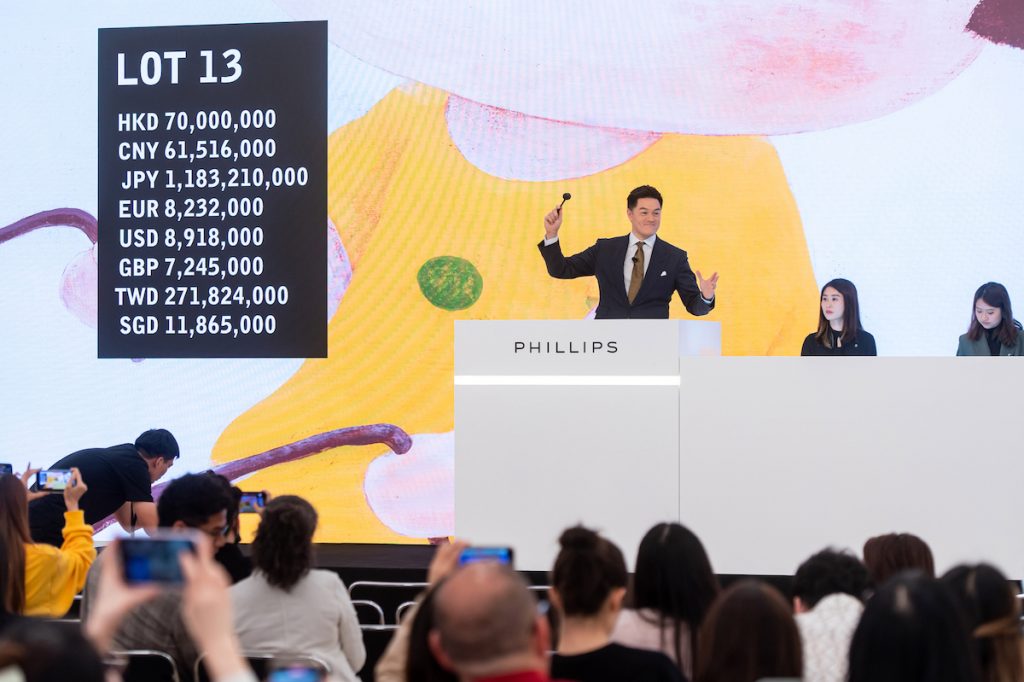The Back Room
The Back Room: Buyer’s Market
The upside of a down market, a brazen art theft on the Lower East Side, a work from Picasso’s "annus mirabilis,” and more.

The upside of a down market, a brazen art theft on the Lower East Side, a work from Picasso’s "annus mirabilis,” and more.

Artnet News

Every Friday, Artnet News Pro members get exclusive access to the Back Room, our lively recap funneling only the week’s must-know intel into a nimble read you’ll actually enjoy.
This week in the Back Room: The upside of a down market, a brazen art theft on the Lower East Side, a work from Picasso’s “annus mirabilis,” and much more—all in a 7-minute read (1,928 words).

Phillips Asia Chairman Jonathan Crockett sells Yoshitomo Nara’s Lookin’ for a Treasure during the inaugural auction in Phillips’s new Asia headquarters.
After more than a year of being stalked by talk of recession, the art market finally evidenced an unmistakable correction this May with the disappointing results of New York’s marquee auctions—the hair-raising Gerald Fineberg auction at Christie’s serving as a particularly shrill canary in the coal mine. However, once the shock wore off and the handwringing began, it became clear that the punctured appetite across much of the art market has a bright side for some: bargains.
For the cover story of the midyear issue of Artnet’s Intelligence Report, our own Katya Kazakina dove into the messy state of the market right now, teasing out some indication of what buyers and sellers can expect in the season ahead, as well as ways the savvy can benefit from the downturn.
(If you need a reminder how bargain-hunting in the art market works, just recall Eli Broad, who rode the early-1990s recession to become art collecting royalty.)
How much did the market decline, exactly? Powered by Artnet’s Price Database, the report serves up a feast of bracing numbers that reveal the business was in a slump before the Fineberg sale. For instance, global auction sales from January 1 through May 20 declined about 14 percent year over year, to just under $5 billion (compared to the $5.8 billion peak of 2022).
To be sure, macroeconomic headwinds—the war in Ukraine, rising interest rates, inflation, and the hassles and costs of Brexit for some market participants—helped drive prices down. But other forces, many particular to the art market, also played a role.
Unlike in sectors from corporate lending to commercial real estate, highly leveraged buying is relatively new to the art market, or at least has only in recent years become broadly available. That means transactions were greased by cheap money, spoiling buyers who began viewing big-ticket purchases as impulse buys. With interest rates rising, that math no longer holds.
The lack of supply is also a factor. Coming off a bulge year, sales of works priced at $10 million or more have contracted 51 percent in 2023—more than any other price bracket. That’s not a symptom of a lack of demand or a lack of supply, but rather of both, Artnet’s Intelligence Report suggests.
Lastly, don’t forget that the spring auction results would probably look even worse were it not for last-minute withdrawals. A new tactic—to further insulate secondary-market trading from transparency?– that’s emerged lately is late-in-the-game withdrawals, some as late as during the sale. To wit, just two withdrawn lots (a Yoshitomo Nara estimated at $12 million to $18 million and a Wade Guyton painting with a $1.2 million low estimate) accounted for almost one-third of Sotheby’s The Now sale in New York this spring.
So where is demand unassailable? According to the Fine Art Group, their clients are looking for classics and tried-and-true blue-chip fare as the market correction settles. Less compelling are speculative purchases, untested names, and “anything uncommercial.” In fact, the $184.2 million spent on ultra-contemporary art this year prior to May 20 marks a 25 percent decline from the same period in 2022.
As always, for those with cash on hand, the key to a smart purchase is the right artwork at the right price at the right time—and when the market drops, that’s often the right time. Asked what he made of the Fineberg sale, advisor Ben Godsill said: “I made out like a bandit.”
The latest Wet Paint tracks where artists from now-shuttered star-making gallery JTT are likely to land, and a flagrant bit of art thievery at Rachel Uffner Gallery.
Here’s what else made a mark around the industry since last Friday morning…
Art Fairs
Auction Houses
Galleries
Institutions
Tech and Legal News
“Think about the impact that YouTube had on a generation of viewers—it completely changed the business. I think we are seeing the beginning of something similar here. The volume of work we will be exposed to is just exploding.”
—Chris Jacquemin, partner and head of digital strategy at William Morris Endeavor, to Artnet News

Pablo Picasso, Femme a la Montre (1932). Collection of Emily Fisher Landau © 2022 Estate of Pablo Picasso / Artists Rights Society (ARS), New York. Courtesy: The Norton Museum of Art
Date: 1932
Seller: Emily Fisher Landau estate
Sale date: TBD, most likely November 2023
Given the art market’s contraction, the stakes could not be higher for the estate of art patron Emily Fisher Landau, who died at 102 earlier this year. Sotheby’s and Christie’s are pitching for the collection, which is estimated at as much as $500 million, according to people familiar with the trove.
The star lot of the group is Pablo Picasso’s Femme à la montre (Woman With a Watch), a 1932 portrait of the artist’s young lover Marie-Therese Walter. The year is considered Picasso’s “annus mirabilis,” and even inspired a 2018 show at London’s Tate Modern.
How much could Femme à la montre be worth?
“Any of those major 1932 Picassos, they all are between $100 million and $200 million,” said Bill Acquavella, whose gallery staged an exhibition in 2008 devoted to Picasso’s works from that year. It included the famous 1932 masterpiece, La Reve, which became infamous after a certain “elbow” accident by casino magnate Steve Wynn. (Wynn sold the painting for $150 million to hedge fund manager Steve Cohen).
Acquavella saw Femme à la montre “in the flesh,” to use the art world parlance, last year when it was part of “A Remarkable Gathering: The Fisher Landau Family Collection” at the Norton Museum of Art in Palm Beach, Florida.
“It’s a very good one,” he said. “It appeared to be in good condition.”
Two top advisors pegged the ideal estimate for the work at $80 million to $120 million; word is the Landau family is aiming for $150 million.
A Christie’s representative declined to comment. Sotheby’s did not immediately respond to a request for comment.
It’s been 13 years since a great 1932 Picasso came to auction. In 2010, a large-scale painting, Nude, Green Leaves and Bust from the collection of Los Angeles patrons Sydney and Frances Brody fetched $106 million, a record at the time.
Two other works from that year came to the auction block in recent years, with Femme nue couchée selling for $67.5 million at Sotheby’s New York in 2022, and Femme assise près d’une fenêtre (Marie-Thérèse) fetching $103.4 million at Christie’s New York in 2021.
—Katya Kazakina